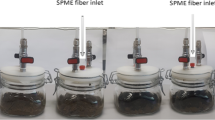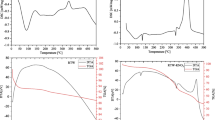Abstract
Activated biochar has been used in various areas, i.e., wastewater treatment. However, biochar contains volatile organic compounds, some of which are toxic organic pollutants that pose health risks to human. In this study, activated biochar was prepared by pyrolysis method using rice husks as raw materials and H2O as the activator. The volatile organic compound concentration of biochar before and after activation, as well as the adsorption characteristics of activated biochar, was investigated. The structure of the biochar was characterized by FTIR, SEM, and specific surface area analyzer. The results showed that activated biochar surface was mainly composed of carboxyl groups, and no phenolic hydroxyl or lactone groups formed during the process. In total, 54 volatile organic compounds were analyzed by a gas chromatography–mass spectrometer. The detection frequency of 45 volatile organic compounds reached 100%. The concentration of sum of these compounds was 93.26 and 110.62 μg/g in the biochar before and after activation, respectively. Results of adsorption experiments showed that the adsorption and resolution of activated biochar to n-hexane were 29.33 and 5.4 mg/g, respectively. Compared to the biochar sample without activation, the activated biochar with the ratio of charcoal to water of 3:1 showed the best adsorption to n-hexane, whose surface area reached 351.23 m2/g.








Similar content being viewed by others
References
Boehm H (1994) Some aspects of the surface chemistry of carbon blacks and other carbons. Carbon 32:759–769
Chen JY, Zhu DQ, Sun C (2007) Effect of heavy metals on the sorption of hydrophobic organic compounds to wood charcoal. Environ Sci Technol 41:2536–2541
Fan Q, Sun J, Chu L, Cui L, Quan G, Yan J, Hussain Q, Iqbal M (2018) Effects of chemical oxidation on surface oxygen-containing functional groups and adsorption behavior of biochar. Chemosphere 207:33–40
Gao K, Jian M, Yu H, Cheng P, Xie Y, Yu P (2016) Effects of pyrolysis temperatures on the biochar and its surface functional groups made from rice straw and rice husk. Environ Chem 35:1663–1669
Gen-Xing P, Zhen-Heng L, Lian-Qin L (2011) Perspective on biomass carbon industrialization of organic waste from agriculture and rural areas in China. J Agric Sci Technol 13:75–82
Gwenzi W, Chaukura N, Noubactep C, Mukome FN (2017) Biochar-based water treatment systems as a potential low-cost and sustainable technology for clean water provision. J Environ Manag 197:732–749
Hale SE, Lehmann J, Rutherford D, Zimmerman AR, Bachmann RT, Shitumbanuma V, O’Toole A, Sundqvist KL, Arp HPH, Cornelissen G (2012) Quantifying the total and bioavailable polycyclic aromatic hydrocarbons and dioxins in biochars. Environ Sci Technol 46:2830–2838
Hernandez-Soriano MC, Kerré B, Kopittke PM, Horemans B, Smolders E (2016) Biochar affects carbon composition and stability in soil: a combined spectroscopy-microscopy study. Sci Rep 6:25127
Hilber I, Blum F, Leifeld J, Schmidt H-P, Bucheli TD (2012) Quantitative determination of PAHs in biochar: a prerequisite to ensure its quality and safe application. J Agric Food Chem 60:3042–3050
Ho S-H, Yang Z-K, Nagarajan D, Chang J-S, Ren N-Q (2017) High-efficiency removal of lead from wastewater by biochar derived from anaerobic digestion sludge. Bioresour Technol 246:142–149
Jang J, Miran W, Divine SD, Nawaz M, Shahzad A, Woo SH, Lee DS (2018) Rice straw-based biochar beads for the removal of radioactive strontium from aqueous solution. Sci Total Environ 615:698–707
Kim P, Hensley D, Labbé N (2014) Nutrient release from switchgrass-derived biochar pellets embedded with fertilizers. Geoderma 232:341–351
Kloss S, Zehetner F, Dellantonio A, Hamid R, Ottner F, Liedtke V, Schwanninger M, Gerzabek MH, Soja G (2012) Characterization of slow pyrolysis biochars: effects of feedstocks and pyrolysis temperature on biochar properties. J Environ Qual 41:990–1000
Liu P, Liu W-J, Jiang H, Chen J-J, Li W-W, Yu H-Q (2012) Modification of bio-char derived from fast pyrolysis of biomass and its application in removal of tetracycline from aqueous solution. Bioresour Technol 121:235–240
Lopez-Anton MA, Gil R, Fuente E, Díaz-Somoano M, Martínez-Tarazona MR, Ruiz B (2015) Activated carbons from biocollagenic wastes of the leather industry for mercury capture in oxy-combustion. Fuel 142:227–234
Nartey OD, Zhao B (2014) Biochar preparation, characterization, and adsorptive capacity and its effect on bioavailability of contaminants: an overview. Adv Mater Sci Eng 2014:715398
Novak JM, Busscher WJ, Laird DL, Ahmedna M, Watts DW, Niandou MA (2009) Impact of biochar amendment on fertility of a southeastern coastal plain soil. Soil Sci 174:105–112
O’Connor D, Peng T, Li G, Wang S, Duan L, Mulder J, Cornelissen G, Cheng Z, Yang S, Hou D (2018) Sulfur-modified rice husk biochar: a green method for the remediation of mercury contaminated soil. Sci Total Environ 621:819–826
Ok YS, Chang SX, Gao B, Chung H-J (2015) SMART biochar technology—a shifting paradigm towards advanced materials and healthcare research. Environ Technol Innov 4:206–209
Schmidt H-P, Kammann C, Niggli C, Evangelou MW, Mackie KA, Abiven S (2014) Biochar and biochar-compost as soil amendments to a vineyard soil: influences on plant growth, nutrient uptake, plant health and grape quality. Agric Ecosyst Environ 191:117–123
Senthilkumar T, Chattopadhyay S, Miranda LR (2017) Optimization of activated carbon preparation from Pomegranate Peel (Punica granatum Peel) using RSM. Chem Eng Commun 204:238–248
Shan D, Deng S, Zhao T, Wang B, Wang Y, Huang J, Yu G, Winglee J, Wiesner MR (2016) Preparation of ultrafine magnetic biochar and activated carbon for pharmaceutical adsorption and subsequent degradation by ball milling. J Hazard Mater 305:156–163
Sing KS (1985) Reporting physisorption data for gas/solid systems with special reference to the determination of surface area and porosity (Recommendations 1984). Pure Appl Chem 57:603–619
Spokas KA, Novak JM, Stewart CE, Cantrell KB, Uchimiya M, Dusaire MG, Ro KS (2011) Qualitative analysis of volatile organic compounds on biochar. Chemosphere 85:869–882
Taherymoosavi S, Verheyen V, Munroe P, Joseph S, Reynolds A (2017) Characterization of organic compounds in biochars derived from municipal solid waste. Waste Manag 67:131–142
Uchimiya M, Chang S, Klasson KT (2011) Screening biochars for heavy metal retention in soil: role of oxygen functional groups. J Hazard Mater 190:432–441
Wang G, Dou B, Zhang Z, Wang J, Liu H, Hao Z (2015) Adsorption of benzene, cyclohexane and hexane on ordered mesoporous carbon. J Environ Sci 30:65–73
Yang H, Kudo S, Hazeyama S, Norinaga K, Masek O, Hayashi J-I (2013) Detailed analysis of residual volatiles in chars from the pyrolysis of biomass and lignite. Energy Fuels 27:3209–3223
Yargicoglu EN, Sadasivam BY, Reddy KR, Spokas K (2015) Physical and chemical characterization of waste wood derived biochars. Waste Manag 36:256–268
Zhang G, Hao Z, Jiang M, Wang H (2011) Study on foreign regulations and standards of stationary sources VOCs emission control. Huan jing ke xue Huanjing kexue 32:3501–3508
Zhang X, Gao B, Zheng Y, Hu X, Creamer AE, Annable MD, Li Y (2017) Biochar for volatile organic compound (VOC) removal: sorption performance and governing mechanisms. Bioresour Technol 245:606–614
Acknowledgements
This work was supported by the National Nature Science Foundation of China (41371448), the Fundamental Research Funds for the Central Universities (3132016326), and the National Key Research and Development Program of China (2018YFC1406405).
Author information
Authors and Affiliations
Corresponding author
Additional information
Editorial responsibility: M. Abbaspour.
Electronic supplementary material
Below is the link to the electronic supplementary material.
Rights and permissions
About this article
Cite this article
Li, J., Li, Q., Qian, C. et al. Volatile organic compounds analysis and characterization on activated biochar prepared from rice husk. Int. J. Environ. Sci. Technol. 16, 7653–7662 (2019). https://doi.org/10.1007/s13762-019-02219-4
Received:
Revised:
Accepted:
Published:
Issue Date:
DOI: https://doi.org/10.1007/s13762-019-02219-4




